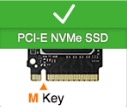
The NVM Express® (NVMe®) family of specifications define how host software
communicates with non-volatile memory across multiple transports like PCI
Express® (PCIe®), RDMA, TCP and more. It is the industry standard for solid
state drives (SSDs) in all form factors (U.2, M.2, AIC, EDSFF). NVM Express
is the non-profit consortium of tech industry leaders defining, managing and
marketing NVMe technology. The latest versions of the family of specifications,
NVMe 2.0 family of specifications, were released on June 3, 2021.
TYPE-C to PCI-e external SSD support:
File System FAT32 NTFS exFAT
All WINXP After WIN7 After
OS MAC OS Read MAC OS
Linux Read Linux
Driver None Mac/Linux Linux
Capacity(GB) 4GB 16TB 64ZB

1. Pin A5 (CC) of the USB Type-C plug shall be connected to GND through a resistor Rd (5.1 kΩ
± 20%). See Section 4.5.3.2.1 and Table 4-25 for the functional description and value of Rd.
2. This table that shielded twisted pair is used for all SDP’s
and there are drain wires. If coaxial wire construction is used, then no drain wires are
present, and the shields of the coaxial wires are connected to the ground pins.
3. Contacts B6 and B7 should not be present in the USB Type-C plug.
4. All VBUS pins shall be connected together within the USB Type-C plug. A 10 nF bypass
capacitor is required for the VBUS pin in the USB Type-C plug end of the cable. The bypass
capacitor should be placed as close as possible to the power supply pad. A bypass capacitor
is not required for the VBUS pin in the Standard-A receptacle.
Shield and GND grounds shall be connected within the USB Type-C plug and USB 3.1 Standard-A
receptacle on both ends of the adapter assembly.
5. All USB Type-C plug pins that are not listed in this table shall be open (not connected)

